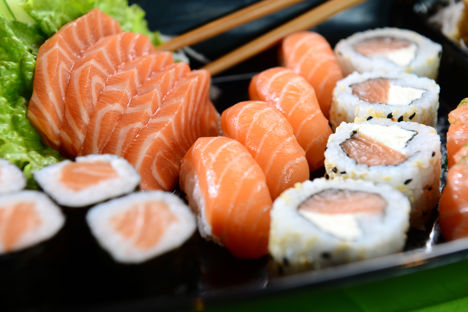
The salmon story: how Norway changed sushi forever
Discover the fascinating tale of how, in 1985, a small Norwegian trade delegation had a monumental effect on Japan's most famous food.
The salmon story: how Norway changed sushi forever
Discover the fascinating tale of how, in 1985, a small Norwegian trade delegation had a monumental effect on Japan's most famous food.
From the boxes of sushi found in the supermarkets to the expertly crafted maki and nigiri found in the world’s very best sushi restaurants, one thing’s for sure – you’re bound to see some pink, translucent slices of salmon somewhere. It’s the raw fish everyone associates with Japanese food – along with tuna – and it’s very hard to imagine a world in which salmon and sushi had nothing to do with one another. But as little as thirty years ago, this was exactly the case. Strangely, it was thanks to a Norwegian fisheries minister that the Japanese developed an appetite for raw salmon.
1970s Japan was a very different place than it is today. Back then, the country was entirely self-sufficient in terms of seafood, producing enough to feed its entire population without the need for imports. This was a particularly impressive feat seeing as the average Japanese person ate sixty kilograms of fish and seafood annually, compared to the global average of fifteen. Tuna and sea bream were the fish of choice for sushi, thanks to their fatty texture and clean flavour. Salmon was part of the diet, but was regarded as an inferior fish that had to be fully cooked and was used to bulk out cheap meals. To serve it raw was perceived as dangerous, as Pacific salmon landed by Japanese fishermen are prone to parasites, meaning the fish had to be cooked through before eating. So how did Norway, a country on the other side of the world, change this?
Fish out of water
In 1974, a delegation of Norwegian MPs travelled to Japan to strengthen relations between the two countries. Among them was Thor Listau, a member of Norway’s fisheries committee. He immediately noticed how tuna was regarded as the very best fish in Japan, demanding high prices at the markets, while poor quality salmon was being fried or dried and sold in large numbers at low prices. At the time, developments in the way Norway farmed salmon meant the country had more fish than it knew what to do with. Thor’s trip seemed to provide a solution to the problem, and he returned home with the idea of selling salmon to the Japanese.
It wasn’t until 1980 that the first Norwegian salmon was exported to Japan. By this time, a combination of overfishing, new fishing regulations and a rapidly increasing population meant Japan could no longer remain self-sufficient, and the government was looking to other countries to meet the domestic demand for fish. This entry into the Japanese market was an important one, but still the fish was being served fully cooked, and exports were nowhere near the number Norway wanted them to be. Thor was tasked with tripling salmon exports to Japan due to his involvement with Norway’s fisheries and past visits to the country. He knew the only way he was going to do this would be to change the way the Japanese regarded salmon. Project Japan was born.
Tom Shingler
Big in Japan
Thor returned to Japan in 1985 with twenty of the country’s best seafood exporters and industry figures, so they could see first-hand the market’s potential. Salmon was certainly being eaten; it just wasn’t seen as a high quality fish and was never served raw. People said the flesh wasn’t colourful enough to be served as sushi, and the fear of parasites meant it was viewed as dangerous. It took Thor and his Project Japan team nearly fifteen years to get raw salmon into the Japanese mainstream.
The first hurdle was explaining to people the differences between Pacific and Norwegian salmon. The Japanese were – unsurprisingly – only used to eating salmon caught in the Pacific. But the Norwegian salmon were bigger, contained healthy fats and – critically – were free of parasites. This made it ideal for serving and eating raw. Thor and his delegation met with Japanese ministers, high-end hoteliers, foodservice influencers and restaurant owners, bringing the finest Norwegian salmon with them. They found that once their hosts had tasted it raw and were educated about the differences between species, raw salmon was a hit.
Eventually, salmon sushi started appearing in restaurants and shops all over Japan. It wasn’t an overnight hit – it took ten years before salmon was regarded alongside tuna and bream as a sushi fish. But Norwegian salmon exports increased by 250% between 1980 and 1994, making Project Japan an immense success, changing Japan’s most famous national cuisine forever. Norwegian salmon is now so highly regarded that restaurants in Tokyo often have photographs of Norway’s stunning coastlines and fjords in their windows, so customers know they’re serving the best. It’s incredible to think that Japan, a country with such deep-rooted culinary traditions, now eats something almost daily which was all but unheard of until the 1980s. The move helped Norway’s fish industry boom, spread sushi all over the world as a healthy, delicious food and is something that Thor and his team of hardworking delegates should be proud of.


